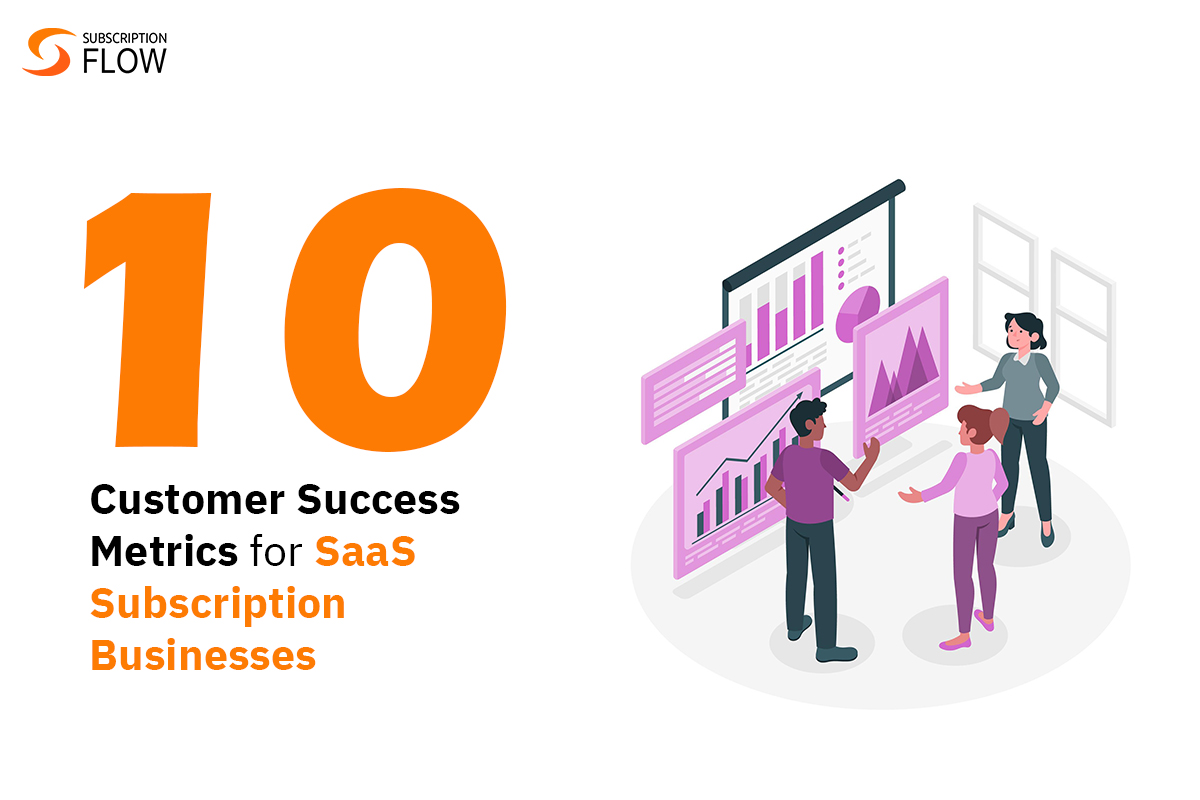
10 Most Important Customer Success Metrics for SaaS Subscription Businesses
Customer success metrics are the key to scrutinizing your company’s performance, goals, and objectives. Without metrics, the business can face several obstacles in viewing the paths to growth goals.
Customer success for SaaS businesses is the lifeblood but to achieve it there must be clear patterns for what to choose for your customer success metrics and how to calculate them.
In customer success metrics, some key performance indicators combine to give the metrics and strengthen the study of metrics.
From the perspective of a SaaS business, the business has to retain the subscribers and it does not only deem for the customer engagement. One has to think out of the box to keep on improving and taking measures that improve customer retention rate.
This article will illustrate the customer success metrics for a SaaS business. Let’s look into them and see what metrics are important for your business to reach its goals.
Also Read: Important SaaS Customer Retention Metrics for Subscription Businesses
What Are Customer Success Metrics and Why Are They Important?
To be exact and precise, customer success metrics are evaluative calculations that are based on key performance indicators (KPIs) that aim to measure the efficacy of strategies, customer satisfaction, and the probability of retaining customers or otherwise.
Customer success metrics deliver insights to the business and help them focus on the strategies for prospects and grow their revenue effectively.
List of Customer Success Metrics – Know How to Calculate
Below is the list of the important customer success metrics among which you can see the ones that are integral to your business and must be adopted.
Average Revenue Per Customer (ARPC) or Average Revenue Per User (ARPU)
Every customer has segments of customers that are high-value and low-value. To keep the check on the customers and revenue generated from them, it is important to calculate the average revenue per customer and segment, accordingly.
To calculate the average revenue per customer, the following calculation would bring the desired results:
Average Revenue Per User = Total revenue / Average number of users
Keeping an eye on ARPU from time to time to check the stability of the revenue helps to optimize the lifetime value of the customers as well.
Monthly Recurring Revenue (MRR)
As the name suggests, monthly recurring revenue evaluates the revenue generated over the month from the subscribers. MRR does not intend to calculate the one-time model rather it calculates the revenue that is generated from the recurring billing. It also calculates the revenue after the application of discounts, coupons, and vouchers.
It is important to calculate the monthly recurring revenue for checking the stability of the revenue. This metric gives you an immediate overview of the business products or services generating revenue and if the customers are repetitive or not.
To calculate the monthly recurring revenue:
MRR = Total Number of active users*Average revenue per user (ARPC)
Trial to Paid Conversion
The main goal of the businesses is to convert users of trial to the paid version of the service or product. Having a high trial to paid conversion rate increases the revenue of the customer and builds good business health. Trial to paid conversion can be calculated quarterly, monthly, or annually.
For that, TTP Conversation Rate aids in determining the viability of your trial period motions. Low TTP Conversion Rates indicate that you should carefully review them. Do you require more in-app tutorials? Are your sales representatives helping them with the trial? It provides information regarding whether the business is getting more conversions or if customers leave the product after trial.
Also Read: Trial Management System
To calculate Trial to paid conversion:
Trial to paid conversion rate = (Number of customers that convert to paid / total number of trial customers) * 100
Customer Retention Rate
For SaaS businesses who work on the subscription model, it is extremely important for them to retain their customers. This metric of customer success has been the most important one for them as it tells the percentage of company retention rate of customers. If we look at the other side of this metric, it can also be linked to the customer churn rate.
To calculate the customer retention rate:
Customer retention rate = (Average number of transactions per month – Average order value)/average customer lifespan in months * 100
Also Read: The Role of Customer Success in the Subscription Business and How to Embrace It to Excel?
Renewal Rate (RR) or Repeat Purchase Rate
The returning customers of any business define them for they are satisfied with the product or service. Building and maintaining loyalty with the customer improves the value of the business, especially with that very customer. However, doing so is not an easy task and the SaaS businesses should focus on their returning or repetitive customers because this ultimately improves the customer retention rate and recurring revenue.
Renewal Rate or Repeat Purchase Rate focuses on the renewal of the subscription or whether they drift away to the competitor (which should not happen in any case). This is one of the SaaS renewal metrics that are integral to revenue.
To calculate the repeat purchase or renewal rate, there are two important variables or numbers to carry out the calculation.
- Your number of customers who made repetitive purchases.
- A total number of customers in the same period of time.
To calculate the Renewal Rate of subscriptions for your business, the following calculation would be performed:
Renewal Rate = Number of customers/contracts renewing at the end of the specified period /total number of customers/contracts scheduled for renewal* 100
Churn Rate
Churn rate is one of the most important customer success metrics and customer health metrics for the fact that it tells about the customers who stopped using the service of the business hence revenue loss. It is extremely important for SaaS companies to calculate churn on a set interval to see if the churn rate is not exceedingly more than the one that is kind of accepted.
You can make this metric as simple or as complex as your needs demand; there are many different ways to monitor churn. But churn is primarily calculated as the number of lost customers or the financial amount that each one of those customers represents.
To calculate the churn rate:
Churn Rate = Number of cancellations in a period/ total number of subscriptions in that period * 100
Customer Engagement
Do your customers actually use the goods or services you offer? If not, your customer success team hasn’t adequately trained them on how to adopt, use, and benefit from the service to drive success. The customer success metric of customer engagement calculates how much product usage is common for the customer.
You may measure user engagement using a number of different metrics. Keeping tabs on how frequently they communicate with your customer success team is an easy solution. It’s best if they communicate with your team more frequently.
The higher the ratio, the more successful and beneficial the product is for your customer.
To calculate customer engagement:
Customer engagement = Daily active user / Monthly active user
Customer Lifetime Value (CLV)
Customer lifetime value is one of the most important metrics for the business. Also known as Lifetime Value or LTV, the metric calculates the total value of the revenue business can generate over the lifetime of a single customer.
This metric is important to understand if the company is going in the right direction or not as it is directly proportional to the customer success of the company.
If the customer lifetime value is higher then it means the SaaS business is making progress. However, otherwise, the business would need to look at the strategies and their implementation to enhance their effectiveness.
To calculate the customer lifetime value, the three pieces of data would be required:
- Annual Revenue Per User
- Customer Relationship In Years
- Customer Acquisition Cost (CAC)
Once you have the gained the above listed, the following calculation shall be used to calculate customer lifetime value:
Customer Lifetime Value = (Annual Revenue Per User * Customer Relationship In Years) – Customer Acquisition Costs
Customer Satisfaction score (CSAT)
Customer satisfaction score is not to be confused with the net promoter score as they are overlapped sometimes. In the customer satisfaction score, the customers are not asked about the likelihood of suggesting the service or product rather they are asked to rate their experience with the company.
Like the net promoter score, the customer satisfaction score is calculated in the percentage and not in the form of numbers. CSAT is solely based on the interaction of the customer with the client because the net promoted score calculates the experience of the customer from A to Z.
To calculate customer satisfaction score:
Customer satisfaction score (CSAT)= (Number of positive scores / numbers of total scores) *100
Net Promoter Score (NPS)
Net Promoter Score (NPS) is substantially the calculated percentile of data that is entirely based on the voice of customer data. It evaluates the extent to which your existing customers would promote the business, service, or product to others.
The net promoter score is usually calculated by conducting surveys that rank on a scale of 10. The survey has usually a question that asks, “How likely are you to recommend our services to a friend or an acquaintance?”
Those who respond to the survey have been categorized depending on the number they rank the service of the business at. The categories are:
Detractors: Customers who respond with a number between 0 and 6
Passives: Customers who respond with 7 or 8
Promoters: Respondents who choose 9 or 10
To calculate the net promoter score:
NPS = % Promoters – % Detractors
Also Read: Combating Churn for a SaaS—Use Content to Attract, Educate, Convert and Retain Customer
Bottom – Line
Customer success metrics cannot be overlooked. Such metrics gauge the value of your business and service among your customers and give you the opportunity to you for enhancing the business along with improvement.




















